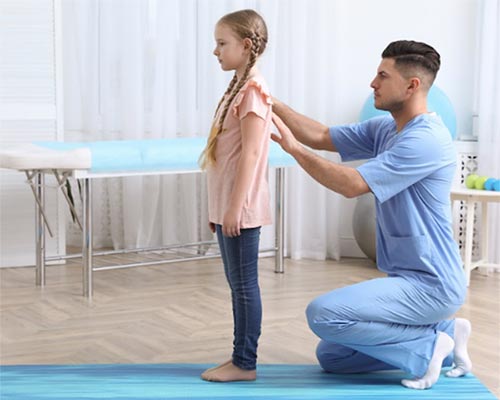
As June is Scoliosis Awareness Month, it’s the right time to shed light on this common spinal condition that affects 6-9 million people in the US.1 Scoliosis is characterized by an abnormal curvature of the spine, which can lead to various complications if left untreated. Learning about the signs and symptoms of scoliosis can help you recognize potential indicators and seek timely medical evaluation and treatment.
Understanding Scoliosis
Scoliosis is a musculoskeletal disorder characterized by an abnormal sideways curvature of the spine. It most commonly emerges during adolescence, when the spine is still growing rapidly. Scoliosis can vary in severity, ranging from mild curvature to more pronounced deformities that impact spinal alignment and posture.
Watch Out for these Early Signs & Symptoms
Uneven Shoulder Height: One of the most common signs of scoliosis is uneven shoulder height. A noticeable difference in shoulder level or asymmetry in the shoulder blades may indicate spinal curvature.
Uneven Waistline: Scoliosis can cause the waistline to appear uneven or asymmetrical. This may manifest as a prominent hip or rib protrusion on one side of the body.
Visible Spinal Curvature: In some cases, scoliosis may be visible as a sideways curvature of the spine when viewed from the back. The spine may appear to have an "S" or "C" shape rather than a straight line.
Changes in Posture: Individuals with scoliosis may exhibit changes in posture, such as leaning to one side or tilting of the pelvis. These alterations in alignment can affect overall body balance and stability.
Back Pain or Discomfort: Scoliosis can cause back pain or discomfort, particularly as the curvature progresses and places strain on surrounding muscles and tissues. Pain may occur in the back, shoulders, or hips, and may worsen with prolonged sitting or standing.
Breathing Difficulties: Severe scoliosis can affect lung function by limiting chest expansion and reducing respiratory capacity. This can lead to shortness of breath, especially during physical activity or exertion.
During Scoliosis Awareness Month, we emphasize the importance of regular screenings, especially for school-aged children. Early intervention can lead to better outcomes and may include treatments like bracing or physical therapy to manage symptoms and prevent further curvature. Surgery is only considered when the spinal curvature affects other vital functions of the body.
If you or someone you know exhibits these signs, consult a healthcare professional for a thorough evaluation. Awareness and education are our best tools in the fight against scoliosis.
AUTHOR: Dr. Payam Moazzaz is a board-certified orthopedic spine surgeon in California specializing in robotic-assisted minimally invasive spine surgery.

